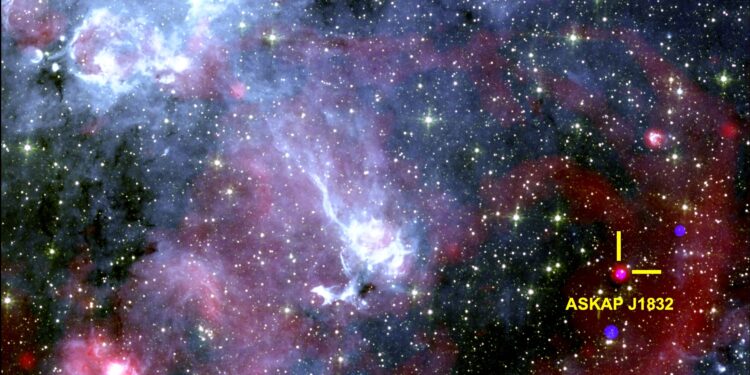An image of the sky showing the region around Askap J1832-0911. X-rays of the NASA X-ray-raycra X-ray observatory, radio-telescope radio data Meerkat and infrared data from the NASA Spitzer space telescope. Credit: Ziteng (Andy) Wang, Icrar
The astronomers of the International Center for Radio Astronomy Research (ICRAR), in collaboration with international teams, have made a surprising discovery on a new type of cosmic phenomenon.
The object, known as Askap J1832-0911, emits radio waves and X-rays for two minutes every 44 minutes.
The article, “detection of X -ray emission from a long -term radio transitional”, is published in Nature.
This is the first time that objects like these, called long-term transients (LPT), have been detected in X-rays. Astronomers hope that this could give an overview of the sources of similar mysterious signals observed in the sky.
The team discovered Askap J1832-0911 using the Askap radioelescope on the country of Wajarri in Australia, owned and operated by the National Agency of Sciences of Australia, CSIRO. They correlated the radio signals with the X -ray impulses detected by the NASA X -ray observatory, which obviously observed the same part of the sky.
“Discover that Askap J1832-0911 emitted radiographs had the impression of finding a needle in a hay boot,” said the main author, Dr. Ziteg (Andy) Wang of the Curtin University of Icrar.
“The Askap radiotelescope has a wide view of the night sky, while Chandra only observes it. It was therefore lucky that Chandra observed the same area of the night sky at the same time.”
The LPTs, which emit radio pulses that occur a few hours or hours, are a relatively recent discovery. Since their first detection by ICRAR researchers in 2022, ten LPTs have been discovered by astronomers around the world.
Radio and radiographic light curves showing how Askap J1832-0911 Pulse in the two bands. Credit: Ziteng (Andy) Wang, Icrar
Currently, there is no clear explanation for what causes these signals, nor why they “light up” and “turn off” at such long, regular and unusual intervals.
“This object is different from everything we have seen before,” said Dr. Wang.
“Askap J1831-0911 could be a magnetar (the nucleus of a dead star with powerful magnetic fields), or it could be a pair of stars in a binary system where one of the two is a highly magnetized white dwarf (a low-mass star at the end of its evolution).”
However, even these theories do not fully explain what we observe. This discovery could indicate a new type of physics or new models of stellar evolution. “”
-
The illustration of this artist depicts the NASA X -ray observatory in space. Credit: NASA / CXC and J. Vaughan
-
CSIRO’s ASKAP radiotelescope on the Wajarri Yamaji country in Australia. Credit: CSIRO
Detection of these objects using X -rays and radio waves can help astronomers find more examples and learn more about them.
According to the second author, Professor Nanda Rea of the Institute of Spatial Sciences (ICE-CSIC) and the Catalan Institute for Spatial Studies (IEEEC) in Spain, “finding one of these objects suggests the existence of much more. The discovery of its transitional X-ray emissions opens up information on their mysterious nature.”
“What was also really remarkable is that this study presents an incredible teamwork effort, with contributions from researchers from around the world with different and complementary expertise,” she said.
Discovery also helps reduce what objects could be. Since X -rays are much higher energy than radio waves, any theory must take into account the two types of emission – a precious index, since their nature remains a cosmic mystery.
Askap J1832-0911 is located in our milky galaxy at around 15,000 light years from the earth.
More information:
Ziteng Wang, detection of X -ray emission from a brilliant long -term radio transitional, Nature (2025). DOI: 10.1038 / S41586-025-09077-W. www.nature.com/articles/S41586-025-09077-
Provided by International Center for Radio Astronomy Research (ICRAR)
Quote: The cosmic mystery deepens while astronomers find a flashing object in radio and X -rays (2025, May 28) recovered on May 29, 2025 from
This document is subject to copyright. In addition to any fair program for private or research purposes, no part can be reproduced without written authorization. The content is provided only for information purposes.



